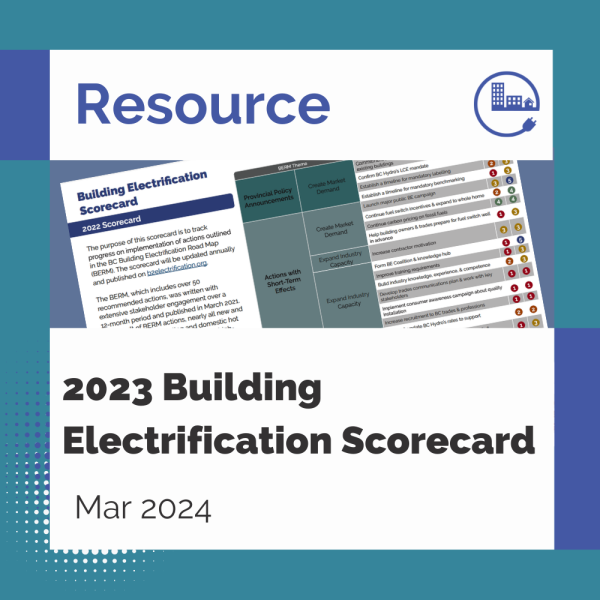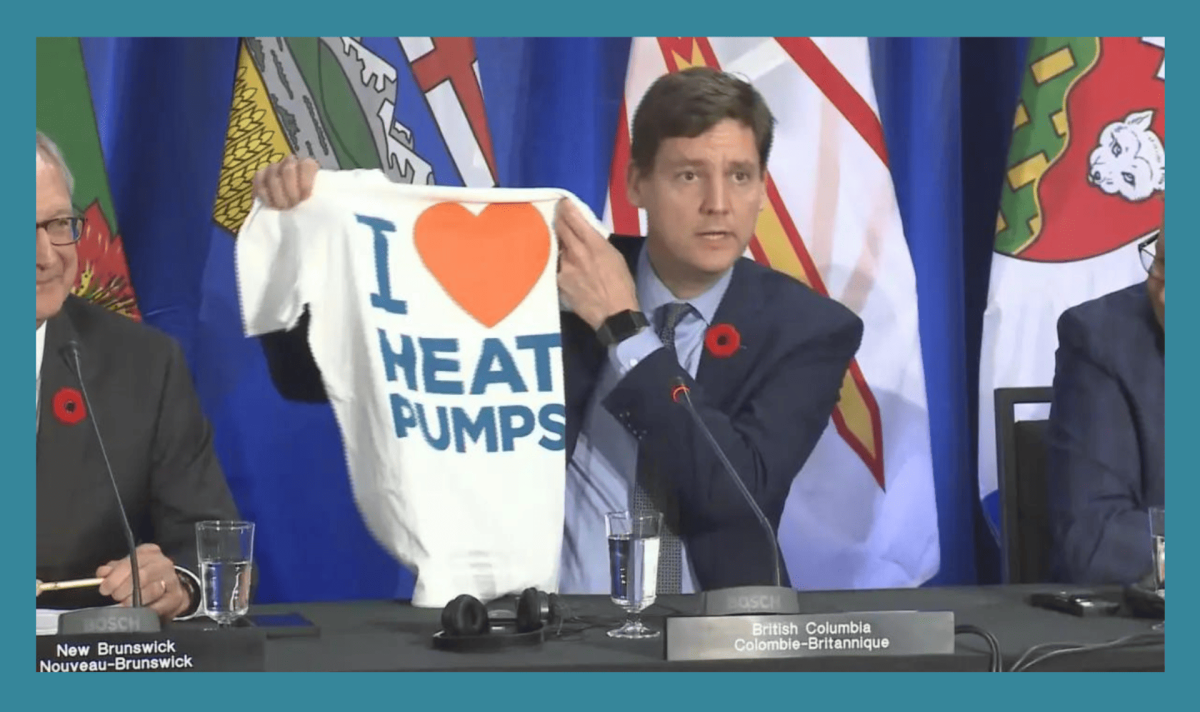
Overview
2023 was a notable year for building electrification. The attached scorecard evaluates progress happening throughout the Province toward the implementation of the BC Building Electrification Road Map (BERM).
2023 Highlights
These additional 2023 highlights are also worth noting:
Introducing the Zero Carbon Step Code (ZCSC)!
-
The ZCSC is a new regulation introduced in May 2023 as part of the BC Building Code updates that limits greenhouse gas (GHG) emissions from new construction. Twenty-one local governments, representing a range of climate zones and population sizes throughout BC's south coast, Vancouver Island, and Okanagan regions, adopted the standards in an accelerated timeline and more are expected to follow suit in 2024.
-
Based on current early adoption (as of January 2024), it is estimated that 44% of all new residential units in large multi-family buildings (e.g., mid-rise and high-rise) and 30% of all new units in small residential buildings (e.g., low-rise and ground-oriented dwellings) will be built in municipalities that have already adopted the ZCSC or equivalent regulations.
BC ♥ Heat Pumps. High-efficiency equipment takes priority.

Premier David Eby holding an I ♥ Heat Pumps t-shirt. Photo courtesy of Global News.
-
The Province began consultations in 2023 with stakeholders on point of sale and point of installation standards for the Highest Efficiency Equipment Standards (HEES) for existing buildings which will take effect in 2030.
-
Updates to the Demand Side Measures Regulation mean that by the end of 2023, conventional gas equipment (with an efficiency of less than 100%) can no longer be incentivized.
Heat pump demand is on the rise!
-
Air-source heat pumps as a main heating system have increased from 5% to 9% of homes in the past three years, and an additional 3% are used for secondary heating. Ground-source heat pumps make up a further 1% of homes. Incentive uptake is rising. In 2022/23, the Province of British Columbia provided 6,018 heat pump rebates; this annual number accounts for more than half of the total heat pump rebates issued since 2018.
-
Responding to this demand has resulted in an increased supply of eligible heat pump retrofit contractors. The Home Performance Contractor Network increased to 546 qualified contractors (a 56% increase over 2022), while specifically prioritizing the regional capacity in northern and rural regions of BC in 2023.
Heat pumps proving to be a cost-effective alternative
-
A new study spearheaded by the District of Saanich and the Capital Regional District proves that energy-efficient heat pumps can lower heating costs in the Province’s milder climates.
-
Heat pumps are also being adopted in colder climates, in both new construction and retrofits. A case study by the Community Energy Association, featuring a new build by K-Country Homes in Cranbrook, BC, demonstrates that all-electric homes are economical and perform well in extreme cold temperatures.
BC Hydro announces call for more renewable power
-
BC Hydro updated its Integrated Resource Plan with accelerated electrification scenarios analyzed. This resulted in a new call for power to be issued in 2024, to bring new infrastructure online as early as 2028.
Coming in 2024...
Support for deep energy and low carbon retrofits is coming!
-
CleanBC and BC Hydro are developing rebate programs to better support retrofits in multi-family buildings.
Mandatory benchmarking in the City of Vancouver begins.
-
The first benchmarking requirement for existing large commercial buildings came into effect with a reporting deadline of June 2024, and with GHGi limits beginning in 2026.
-
Vancouver continues to support existing building owners with new and upcoming reporting requirements.
-
Other local governments, such as Victoria and Saanich, are developing energy and carbon emissions reporting requirements for large buildings and expect to bring proposed program recommendations to their councils in 2024.
Provincial home energy labelling is on the way
-
Currently in development, a new voluntary virtual home energy rating system, BC Home Energy Planner, will be piloted in several communities in 2024.
The right skills to get the job done
-
Low carbon trades training in small and large buildings is a priority at the provincial level. New microcredentials are currently in development in post-secondary institutions and will be listed on TradeUp BC.
-
Industry associations and private companies, both provincially and nationally, are also responding to the need to train trades on new technologies and best practices.
Keeping electricity affordable
-
According to a 2023 study comparing rates across North America, BC continues to deliver some of the cheapest rates. Ranking 3rd in most rate classes, the Province is continuing to deliver clean and affordable power.
-
BC Hydro introduces an optional rate for residential customers that can help to save money if electricity usage is shifted to lower price periods. This time-of-use (TOU) rate will be most attractive to households that charge electric vehicles at home and will be available to opt-in as early as June.
-
In January 2024, the Province announced a $36-billion investment to support BC Hydro’s 10-year capital plan. These investments include support for electrification with community and regional infrastructure projects that will deliver clean, affordable electricity to people and businesses in the future.
Areas where more work is needed
Expanding infrastructure
-
While building electrification typically happens over time when equipment is due to be replaced, there are currently some electrical capacity-constrained regions that need additional attention. In these areas, building out infrastructure can take time, and result in project delays. As mentioned above, new investment from the Province includes infrastructure upgrades to transmission and distribution systems.
Affordability of retrofits
-
The cost to retrofit existing equipment to heat pumps and other electrification technologies is higher than a like-for-like gas replacement. However, when comparing projects that have cooling as an additional benefit, the business case improves greatly.
-
Increasing the adoption rate of technologies is expected to result in additional manufacturers and models available, which can reduce capital costs. Additional areas that can impact electrification project costs in large buildings include engineering cost buffers and an expanded workforce.
-
Availability of attractive financing for multi-family buildings, such as stratas, continues to be a gap. New financing models continue to be explored by multiple parties.
Cold climate confidence
-
While there is significant literature and field studies proving that heat pumps operate efficiently in cold climates, there is still a need to build confidence in heat pump design and installation in colder parts of the province.
-
New Energy Step Code-compliant buildings can make heat pumps an easy sell because they are ready-made with high-efficiency equipment and building envelope. Some retrofits, however, may require window upgrades, increased insulation, air sealing or ductwork before a heat pump is a fully viable heating solution.
-
For some retrofit applications, hybrid systems that use both a gas furnace or boiler and electric heat pump may prove to be a more viable solution. It is critical, though, that these systems are installed and operated in a way that leads to meaningful carbon reductions.
Rate redesign
-
BC Hydro’s current extension policy can penalize building owners who want to upgrade their service for electrification if it triggers upstream upgrades on its local distribution network. A rate application is anticipated for June 2024 that will look to reduce the impacts of line extensions to projects that trigger these kinds of system upgrades.
Refrigerant phase-down
-
More equipment options with low global warming potential (GWP) refrigerants are needed to meet upcoming hydrofluorocarbon (HFC) phase-down requirements.
 b2e@zeic.ca
b2e@zeic.ca


